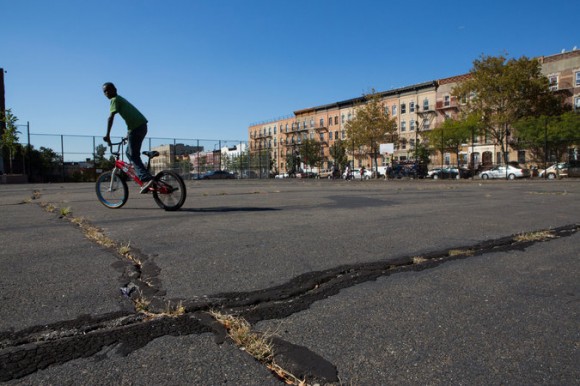At Bowne Playground in Queens, Mayor Bill de Blasio is expected to announce on Tuesday an ambitious initiative that would channel some $130 million into tattered parks and playgrounds in low-income neighborhoods across New York City, according to several people briefed on the plan.
Many people could not find them on a map: Ranaqua Park in Mott Haven in the Bronx. Saratoga Ballfields in Brownsville, Brooklyn. Luther Gulick Park on the Lower East Side of Manhattan.
They are the hardscrabble neighborhood parks that, advocates say, were overlooked during the Bloomberg administration, even as billions of dollars flowed to big-ticket legacy projects in wealthier parts of the city.
The parks equity plan comes after months of wrangling over how to finance the initiative. During his campaign, Mr. de Blasio endorsed a plan to force the private groups that raise money for the city’s richest parks to hand over as much as a fifth of their budgets to needier parks.
But as with the living wage law signed last week, and his push for universal prekindergarten classes, Mr. de Blasio chose to compromise on the methodology in order to achieve the core of his goals. The park plan relies on public funding, not private dollars, in its quest to address the disparities in the city’s vast park system.
Under Mayor Michael R. Bloomberg, the city committed $6 billion to capital projects in the parks, but they tended to be highly visible projects like the High Line in Chelsea; Brooklyn Bridge Park, along the East River waterfront; or Governors Island. He also poured hundreds of millions of dollars into several park projects in more modest communities, including the revival of the long-shuttered McCarren Pool on the Greenpoint-Williamsburg border in Brooklyn.
Often left behind, however, were the half-acre parks and playgrounds sandwiched between tenements. Under Mr. de Blasio’s plan, 35 of those parks will share the $130 million infusion, plus additional money for maintenance. The parks are all heavily used open spaces in poor neighborhoods that struggle with high obesity and asthma rates. The parks on the list have had little to no investment in recent years.
Mark D. Levine, a city councilman from Upper Manhattan who is chairman of the parks committee, praised the plan, particularly its use of public funds. Requiring the largest conservancies to give a portion of their budgets to neighborhood parks, he said, would have yielded $15 million at most. Conservancy leaders had said that it could scare off donors and force staff layoffs.
The money, Mr. Levine acknowledged, “is not enough to touch every park in the system, but it will have a transformative impact on these parks.”
Mr. Levine added, “It largely answers the question of whether we’ll solve the equity problem through public investment or taking money from the conservancies.”
But to put the figures in perspective, the Central Park Conservancy, the nonprofit group that runs the city’s flagship park, received a single $100 million gift in October 2012 from the hedge fund manager John A. Paulson; it spends $44 million annually to help operate the park.
At the same time, the percentage of the city’s budget going to parks has dropped, according to Mr. Levine. Parks spending made up 0.52 percent of city spending in 2000, down from 0.86 percent in the 1980s and 1.5 percent in the 1960s.
Parks spending for the current fiscal year was budgeted at about $950 million. But the parks department does not control how all of that money is spent. Instead, the choice of what capital projects to fund often is made by City Council members and borough presidents. If the local City Council members put their discretionary money elsewhere, parks in their districts are left to deteriorate.
Of the $130 million, $80 million represents an increase to the parks capital budget. It was proposed by Mr. Bloomberg in his final budget plan. Mr. de Blasio added $50 million. State Senator Daniel L. Squadron has been a proponent of having conservancies share their wealth. He sponsored a bill requiring conservancies with operating budgets of $5 million or more to dedicate 20 percent to neighborhood parks. Only a handful of conservancies are that well-endowed.
While Mr. de Blasio had embraced Mr. Squadron’s proposal during the campaign, he seemed to back off when he announced his new parks commissioner, Mitchell J. Silver, last spring. At a news conference, Mr. de Blasio called the Albany bill “creative” and “productive,” but stopped short of endorsing it.
Still, on Monday, conservancies and representatives from City Hall were continuing to discuss their role, which could include fund-raising on behalf of struggling parks or helping with maintenance.
Mr. Squadron said that he was not disappointed by the lack of a financial commitment from the conservancies. His legislation, he said, helped start a conversation about park equity. “A year and a half ago, folks were not talking about parks equity and now the mayor is addressing the biggest inequities in the system,” Mr. Squadron said. “Having the conservancies at the table beyond this step is a critical piece of the long-term picture.”
Ranaqua Park, a tiny patch of grass with a playground and basketball court in the South Bronx, made the cut for the park-equity plan and stands to reap more than $3 million in capital money.
On a recent weekday, residents said that money could correct the uneven surfacing on the playground and smooth out the court. It might also pay for landscaping for the patchy lawn. The idea got Benjamin Rosa, 15, who lives a block from the park, dreaming: “We could have new sprinklers, and maybe two basketball courts instead of one,” he said.
